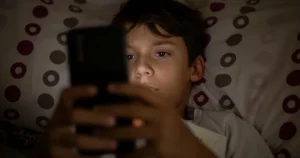Learn about online grooming
Learn about online grooming, including what it is, where and how it can happen online and what the risks are to children as they navigate their online world.
 Close video
Close video
Quick tips
4 things you need to know about online grooming
Here are some questions from parents that we have compiled to provide more information about the risks of exposure to online grooming.
A survey (Hopes and Streams) from the London Grid for Learning revealed that 2 in 5 young people had never told anyone about the worst thing that had happened to them online. With this in mind, it is very hard to know the statistics on this.
A study by the IWF revealed that a large number of children were being groomed, coerced and blackmailed into livestreaming their own sexual abuse over webcams, tablets and mobile phones.
The research took place over a three month period and identified 2,082 images and videos of livestreamed child sexual abuse. It revealed that 98% of images found were of children aged 13 and under, 28% were aged 10 or under and the youngest victim was just three-years-old.
Although these figures are quite shocking, there are things that can be done to ensure children are safe if they choose to livestream. One of the key things is to talk to them about the risks. For younger children, be in the room when they are livestreaming to make sure they are staying safe. See our full livestreaming and vlogging guide for more support.
A UK study by Psychologist Cristina Izura at the University of Swansea revealed that online groomers rarely pose as children and can succeed in persuading a child to meet in less than an hour.
The study also showed that there is not one kind of online groomer but different profiles that groom children in different ways. Online groomers use language to build trust, isolate and remove a child inhibitions towards sexual behaviour.
If your child is not active on social media, they may be at a lower risk of being exposed. However, groomers don’t just use social media to talk to children. They also use chat rooms, online communities, gaming sites and dating apps.
- What is online grooming?
- Online grooming facts and statistics
- It may cause emotional distress
- Where can online grooming happen?
- Online grooming and the law
- Is my child being groomed?
- Recommended resources
What is online grooming?
There’s a chance that your child may meet people online that aren’t who they say they are. Grooming is a word used to describe people befriending children in order to take advantage of them for sexual abuse and other forms of child abuse. Many parents worry about online grooming, so it’s important to talk to your children about how to stay safe.
Online grooming facts and statistics
Concern – Almost one in five young people who shared nudes were either blackmailed, bullied or harassed to send more photos. Source: Cybersurvey – In Their Own Words – The Digital Lives of Schoolchildren
Concern – 30% of 12-15-year-olds said they had been contacted by a stranger online who wanted to be their friend. Source: Ofcom – Children and parents media use and attitudes report 2020-21
It may cause emotional distress
It’s easy to pretend to be someone else on the internet, which is frequently known as online impersonation. Children can sometimes end up having conversations with people whose real identities they may not know.
Kayleigh’s Love Story is a dramatisation of real events that show the dangers of grooming created by the Leicestershire Police to tackle sexual abuse and exploitation
 Close video
Close video
Online groomers may use a fake profile
Groomers may use a social network or go on social media platforms used by young people and pretend to be one of them. They might attempt to gain trust by using fake profile pictures, pretending to have similar interests, offering gifts and saying nice things to the child. The child might not yet have the emotional intelligence to judge whether someone is genuine.
Groomers build trust between themselves and the child
Once they have the child’s trust, the groomer often steers the conversation towards their sexual experiences, even asking them to send sexual photographs or videos of themselves. Some may try to set up a meeting or even blackmail children by threatening to share the pictures or videos with the child’s family and friends.
Existing relationships may be exploited by a groomer
Online groomers are not always strangers. In many situations, they may already have met them through their family or social activities and may use the internet to build rapport with them. Sometimes children don’t realise they’ve been groomed and think that the person is their boyfriend or girlfriend.
Where can online grooming happen?
Online groomers target children on sites and platforms popular with young people. On social media, online groomers will often target a number of young people at any one time by sending out friend requests to see who responds. Through online forums and online games, they may strike up a conversation to build a relationship with a child and ask them to continue talking on another platform or chat privately.
It’s important to note that online communities like Childline can help support children on issues they may not feel able to openly talk about with parents. However, if your child is active on social or online forums, it’s important to make sure they know how to report to CEOP if they come across anyone that they suspect is a potential danger.
A short video about ‘Murder Games‘ the docudrama of Breck Bednar, a 14-year-old schoolboy who was lured to his death after being groomed online while gaming.
 Close video
Close video
Online grooming and the law
In April 2017, the UK Government introduced the Sexual Communication with a Child offense giving the police the power to charge adults who send a sexual message to children in England and Wales.
The aim is to stop abuse before it starts. Over 2020, there were 10,000 cases of online grooming offenses recorded by the police under the new law.
Due to the scale of the issues, the UK Government has committed to doing more to tackle online child sexual exploitations by working with the tech industry to stop online child sexual abuse, sharing solutions and best practices to improve the response.
Many organisations are looking for tech tools to alert and stop images of abuse being shared online. Google previously announced their AI tools created to do just that.
Is my child being groomed?
Online grooming may be hard for parents to recognise because it can happen when children are at home. Also, groomers may specifically warn children not to talk to anyone about it. There are a number of signs to be aware of (although a lot of them are quite common among teens), but look out for increased instances of:
- Wanting to spend more and more time on the internet
- Being secretive about who they are talking to online and what sites they visit
- Switching screens when you come near the computer
- Possessing items – electronic devices or phones – you haven’t given them
- Using sexual language you wouldn’t expect them to know
- Becoming emotionally volatile
Recommended resources
Featured online grooming articles
 Q&A
Q&A
What can parents learn from the ‘Adolescence’ series on Netflix?
Experts share tips to help parents navigate discussions about 'Adolescence' on Netflix.
 Research
Research
Teen girls’ experiences of harm online
Our latest Digital Wellbeing Index report shows that teen girls experience significantly more negative outcomes online than other children.
 Expert opinion
Expert opinion
How to counter online hate and extremism with young people
Hate and Extremism Analyst, Hannah Rose, shares insight into how young people might get involved online. Learn how to counter online hate.
 Research
Research
Our Greater Manchester pilot project: Introducing Bee Smart
We are thrilled to have received funding from the Government’s Media Literacy Taskforce Fund for the Bee Smart project.
 Q&A
Q&A
How teachers tackle online child-on-child abuse in schools
Expert and teacher Dr Tamasine Preece discusses the struggles teachers face when it comes to online child-on-child abuse.
